- 9 Minutes to read
- Print
- DarkLight
- PDF
Feedback Coverage
- 9 Minutes to read
- Print
- DarkLight
- PDF
Using the Feedback Coverage dashboard, school leaders can immediately answer questions like:
- How often is feedback being given?
- Who is receiving feedback?
- Who is giving feedback?
- Who is not receiving feedback?
- Who is not giving feedback?
- Is feedback being given evenly across the Habits?
This dashboard can be used as a monitoring tool so that leaders can find out very quickly if feedback is being given and received with the intended regularity.
To access this dashboard, navigate to Dashboards > Feedback Coverage
Applying filters to the Feedback Coverage dashboard
Below is a key with descriptions of all the features available on your Feedback Coverage dashboard.

| Area | Feature description |
|---|---|
| 1 | Click on the filter icon to hide or reveal the filters box |
| 2 | Click on 'Clear all' to clear all filters |
| 3 | Click on 'My Searches' to access past searches you have saved (See the 'Using My Searches' section below) |
| 4 | Use the 'Academic Year' filter to switch between academic years (The current academic year is the default year when you navigate to the page) |
| 5 | Use the 'Timeframe' filter to determine the time period for which you wish to view your data (See the 'Selecting different timeframes' section below for a full explanation) |
| 6 | Use the 'Teacher Type' filter to view data for one or more groups of teachers |
| 7 | Click on 'Apply filters' to apply the filters you have selected |
| 8 | Click on 'Cancel' to hide the filters box |
Using 'My Searches'
The 'My Searches' button allows you to save your favourite filter settings in all dashboards.
Below is a key with descriptions of all the 'My Searches' features.
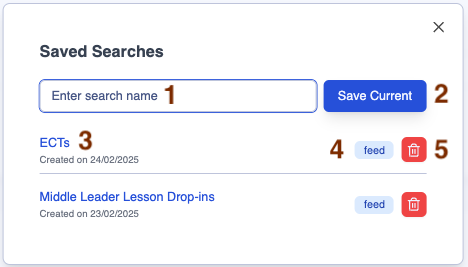
| Area | Feature description |
|---|---|
| 1 | Field to enter your preferred search name |
| 2 | Click on 'Save Current' to save the current set of filters you have applied to the dashboard |
| 3 | Click on the hyperlink to open the dashboard with your preferred filters |
| 4 | This box indicates the dashboard to which this saved search applies |
| 5 | Click on the rubbish bin icon to delete the saved search |
Saving a new search
Step 1
Select the filters you want to apply in the dashboard, for example:
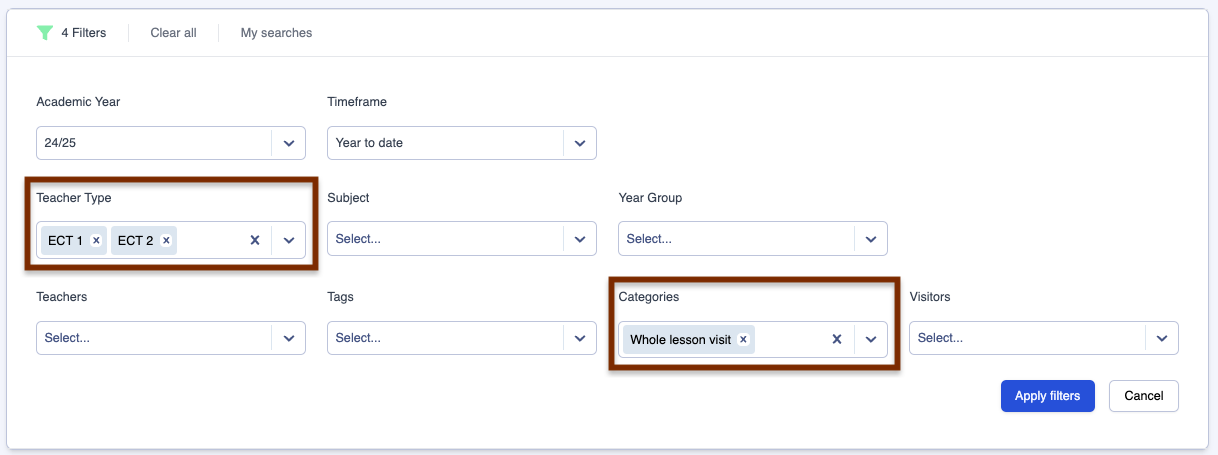
Step 2
Click on the 'My searches' button then enter your preferred search name, for example, 'ECT whole lesson feedback'.
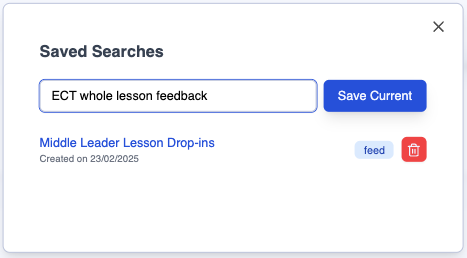
Step 3
Click on 'Save Current' to save your search name along with the selected dashboard filters.
Selecting different timeframes
1. Year to date
The default setting is 'Year to date', so the data you are viewing when you first land on the page is from the first day of this academic year up to today.
2. Half term range
In the 'Timeframe' filter, select 'Half term range', then specify the 'Start Term' and 'End Term' to compare the data between two half terms.

Click on 'Apply filters' (Area 7 in the key above) to apply the filters you have selected.
3. Specific date range
In the 'Timeframe' filter, select 'Date range' then click in the 'Date Range' filter to reveal a calendar. Select a start date and an end date in the calendar. Your selected date range will then be highlighted in navy blue.
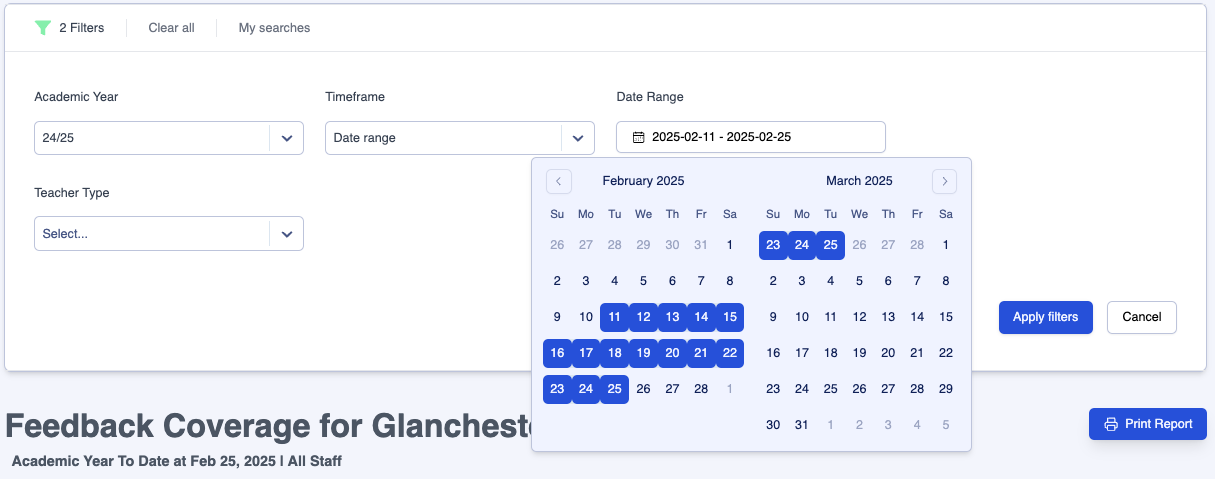
Click on 'Apply filters' to apply the filters you have selected.
Feedback Coverage dashboard 'Overview'
Below is a key with descriptions of all the features available in the 'Overview' section of your Feedback Coverage dashboard.
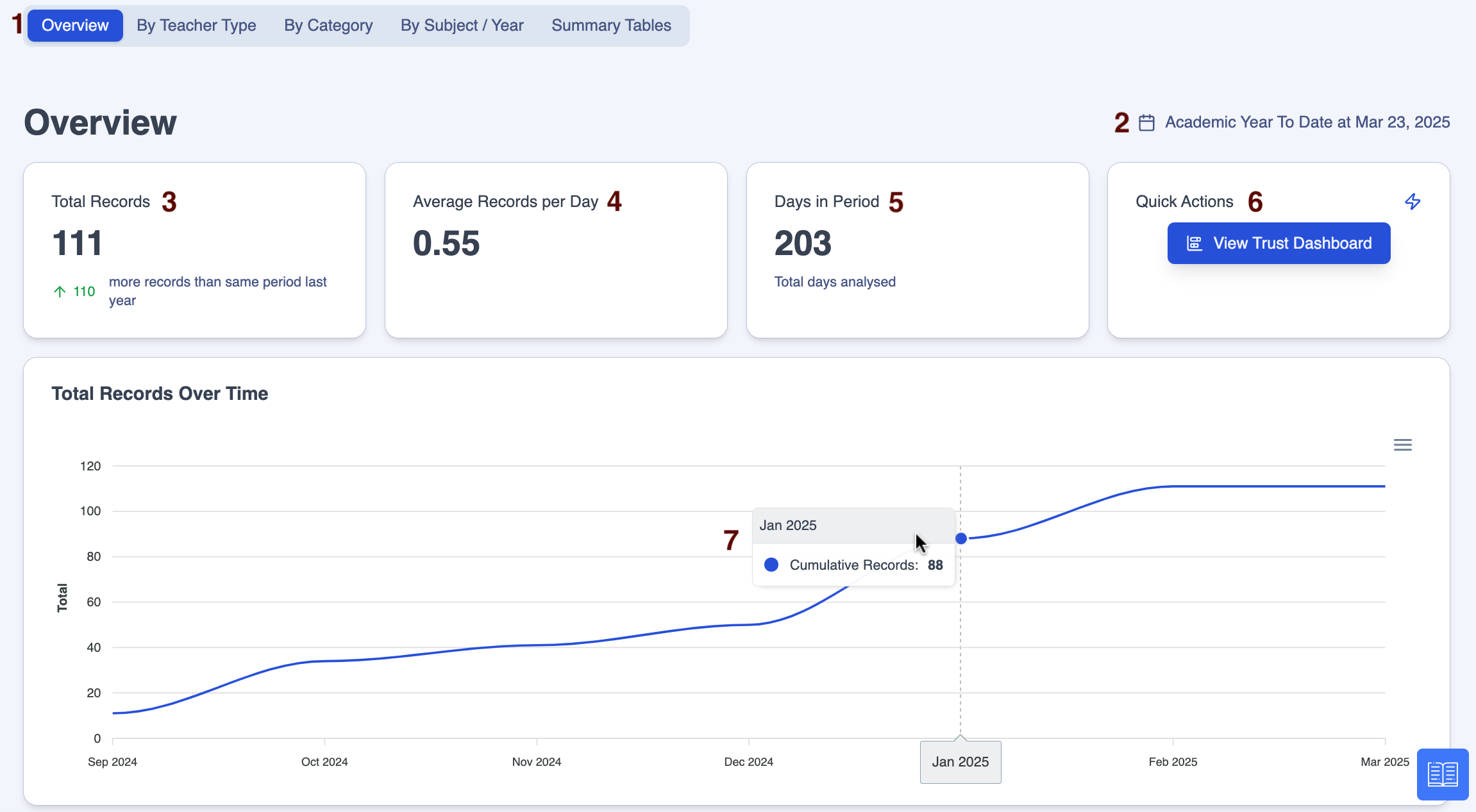
| Area | Feature description |
|---|---|
| 1 | 'Overview' is highlighted, indicating that data from all feedback records is represented in this section |
| 2 | This header displays the timeframe selected in the filters table |
| 3 | The 'Total Records' tile displays the total number of feedback records created for the selected timeframe as well as a comparison with the same period from last year, where available |
| 4 | The 'Average Records per Day' tile displays the average number of feedback records created per school day for the selected timeframe |
| 5 | The 'Days in Period' tile displays the number of school days that were counted in this analysis |
| 6 | The 'Quick Actions' tile gives you the option to click on the 'View Trust Dashboard' button to view the equivalent data at trust level, if you have the relevant permissions |
| 7 | Hover over the line graph to show the 'Cumulative Records' total month on month |
Feedback Coverage dashboard 'By Teacher Type'
Below is a key with descriptions of all the features available in the 'By Teacher Type' section of your Feedback Coverage dashboard.
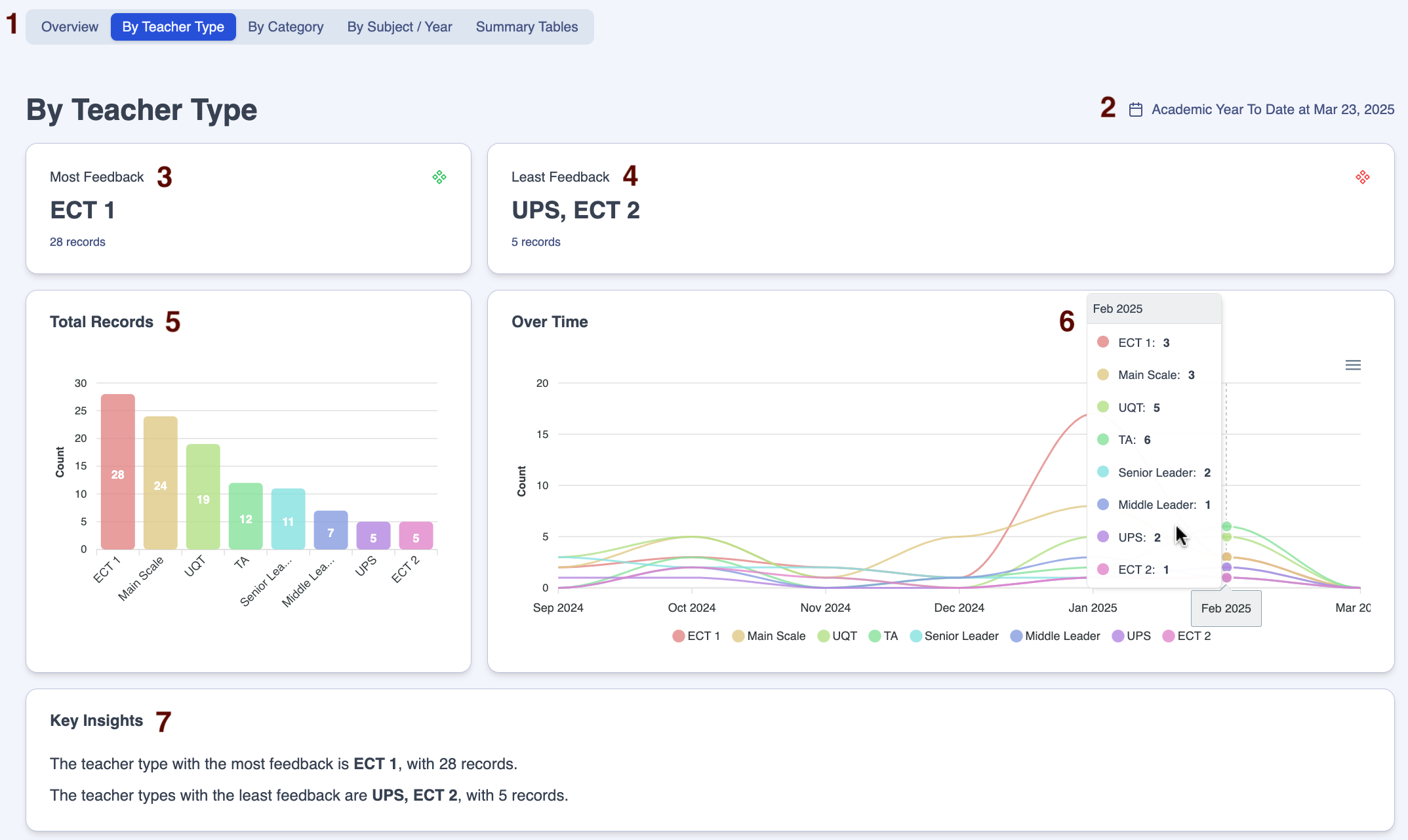
| Area | Feature description |
|---|---|
| 1 | 'By Teacher Type' is highlighted, indicating that the headlines in this section relate to the frequency of feedback records created by Teacher Type |
| 2 | This header displays the filters selected |
| 3 | The 'Most Feedback' tile displays the Teacher Type that has received the most feedback in the selected timeframe |
| 4 | The 'Least Feedback' or 'No Feedback' tile displays the Teacher Type that has received least feedback in the selected timeframe |
| 5 | The 'Total Records' graph displays a breakdown of the count of feedback records created by Teacher Type from highest to lowest in the selected timeframe |
| 6 | The 'Over Time' graph displays a breakdown of the number of feedback records created by Teacher Type month on month in the selected timeframe. Hover over the graph to reveal a summary of the data for a specific month |
| 7 | The 'Key Insights' tile provides summary sentences about the data |
Feedback Coverage dashboard 'By Category'
Below is a key with descriptions of all the features available in the 'By Category' section of your Feedback Coverage dashboard.
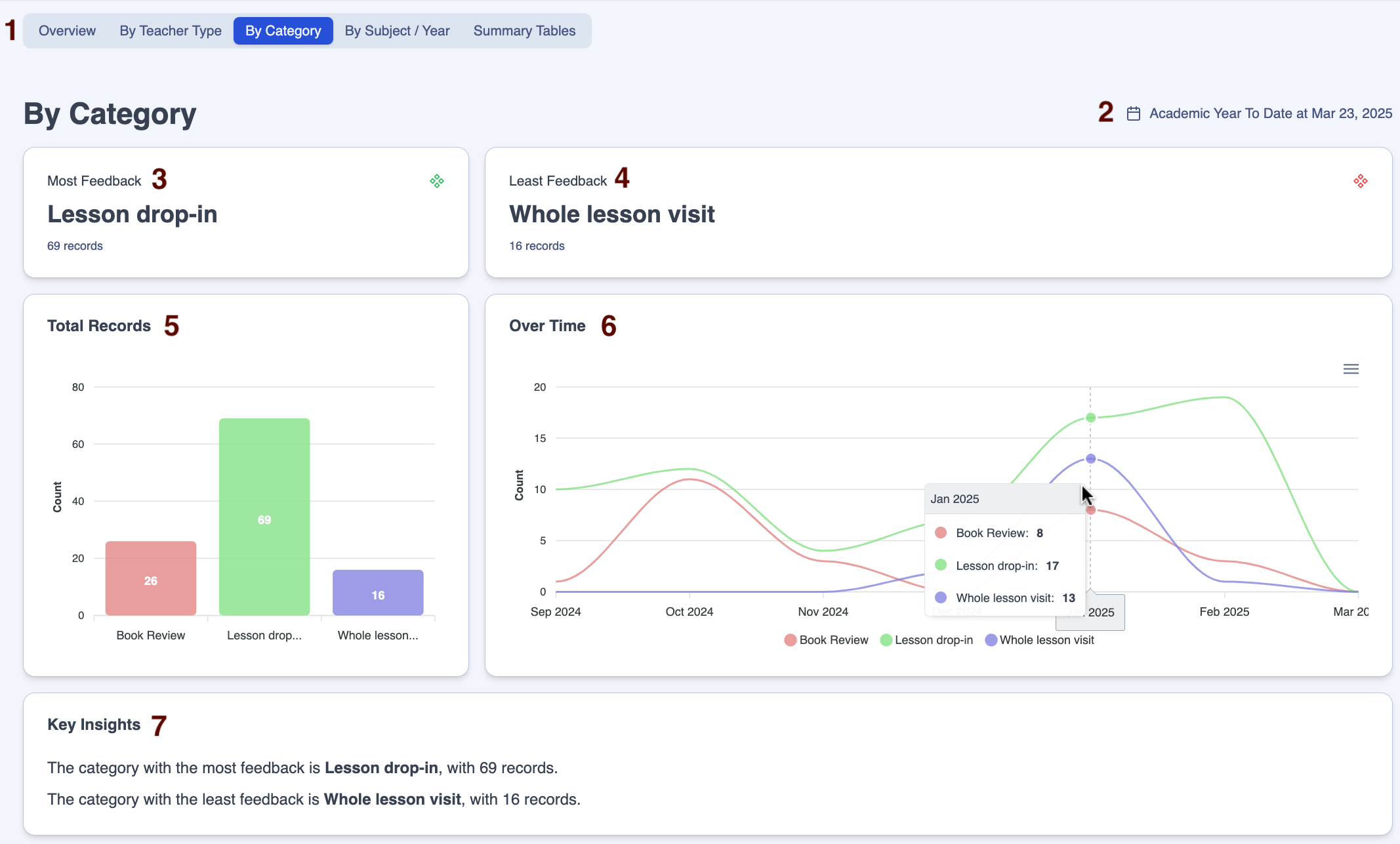
| Area | Feature description |
|---|---|
| 1 | 'By Category' is highlighted, indicating that the data in this section shows a breakdown of feedback records created by feedback category |
| 2 | This header displays the timeframe selected in the filters table |
| 3 | The 'Most Feedback' tile displays the feedback category for which the most records have been created in the selected timeframe |
| 4 | The 'Least Feedback' tile displays the feedback category for which the fewest records have been created in the selected timeframe |
| 5 | The 'Total Records' graph displays a breakdown of the total number of feedback records created by category in the selected timeframe |
| 6 | The 'Over Time' graph displays a breakdown of the number of feedback records created by Category month on month in the selected timeframe |
| 7 | The 'Key Insights' tile provides summary sentences about the data |
Feedback Coverage dashboard 'By Subject / Year'
Below is a key with descriptions of all the features available in the 'By Subject / Year' section of your Feedback Coverage dashboard.
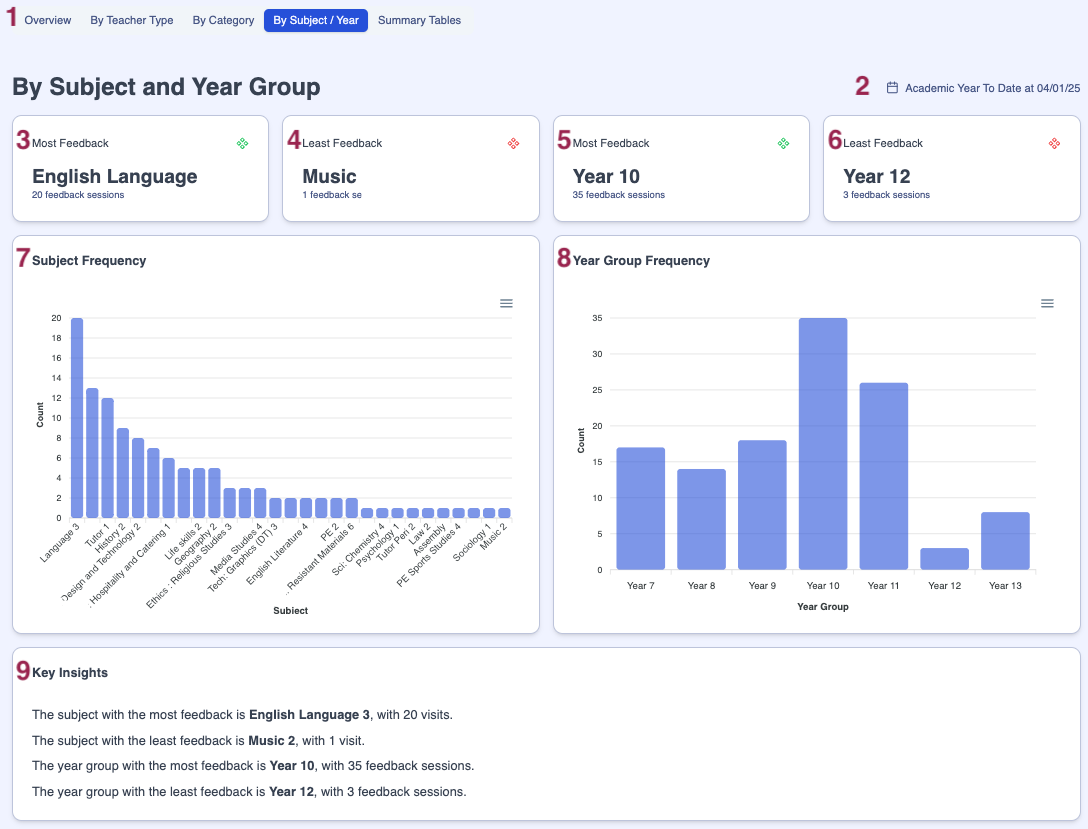
| Area | Feature description |
|---|---|
| 1 | 'By Subject / Year' is highlighted, indicating that the data in this section shows a breakdown of feedback records created by subject and year group |
| 2 | This header displays the timeframe selected in the filters table |
| 3 | The 'Most Feedback' tile displays the subject for which the most feedback records have been created in the selected timeframe |
| 4 | The 'Least Feedback' tile displays the subject for which the fewest feedback records have been created in the selected timeframe |
| 5 | The 'Most Feedback' tile displays the year group for which the most feedback records have been created in the selected timeframe |
| 6 | The 'Least Feedback' tile displays the year group for which the fewest feedback records have been created in the selected timeframe |
| 7 | The 'Subject Frequency' graph displays a breakdown of the count of feedback records created by subject from highest to lowest in the selected timeframe |
| 8 | The 'Year Group Frequency' graph displays a breakdown of the count of feedback records created by year group in the selected timeframe |
| 9 | The 'Key Insights' tile provides summary sentences about the data |
Feedback Coverage dashboard 'Summary Tables'
Below is a key with descriptions of all the features available in the 'Summary Tables' section of your Feedback Coverage dashboard.
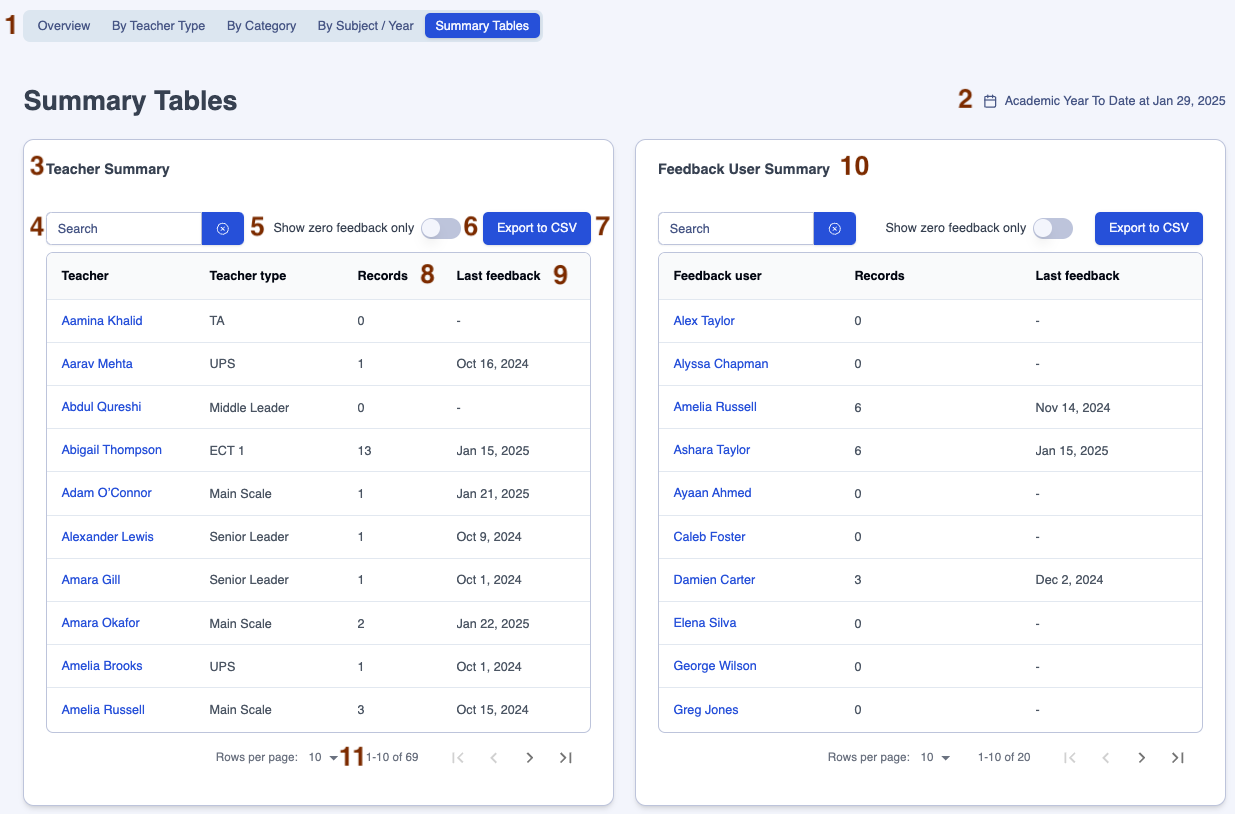

| Area | Feature description |
|---|---|
| 1 | 'Summary Tables' is highlighted, indicating that this section is displaying summary tables of feedback received and feedback given |
| 2 | This header displays the timeframe selected in the filters table |
| 3 | The 'Teacher Summary' table displays records of how often teachers have received feedback in the selected timeframe |
| 4 | Start typing a teacher's name or 'Teacher Type' in the 'Search' box to filter the table |
| 5 | Click on the 'x' next to the 'Search' box to clear the contents |
| 6 | Click on the 'Show zero feedback only' button to view teachers who have received no feedback in the selected timeframe |
| 7 | Click on the 'Export to CSV' button to download the table into spreadsheet format |
| 8 | Click on the 'Records' column header to sort the count from lowest to highest, then click again to sort from highest to lowest |
| 9 | Click on the 'Last feedback' column header to sort the dates so you can immediately see which teacher received feedback the furthest back in time and the most recently |
| 10 | The 'Feedback User Summary' table displays records of how often leaders have given feedback in the selected timeframe |
| 11 | Click on the 'Rows per page' dropdown arrow then select 15, 20, 25 or 30 to change the number of rows displayed in the table |
| 12 | The 'Coverage by Habit' table displays the spread of feedback recorded against each Habit in the selected timeframe |
| 13 | The 'All Feedback users' row displays the total number of pieces of feedback recorded by all leaders against each Habit in the selected timeframe |
Exporting data from the Feedback Coverage dashboard
There are three ways to export data from your Feedback Coverage dashboard.
1. Exporting the whole dashboard
Export the whole Feedback Coverage dashboard in PDF format by clicking on the 'Print Report' button on any of the dashboard pages.

2. Exporting graphs
Click on the 'Burger' (the three straight lines) next to any graph to export in SVG (image), PNG (image) or CSV (spreadsheet) format.
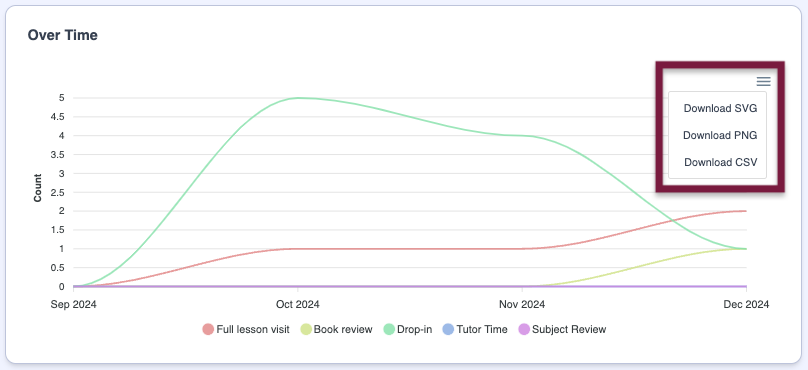
3. Exporting information from Summary Tables
Navigate to Dashboards > Feedback Coverage > Summary Tables then click on the 'Export to CSV' button on either of the tables to download the data in spreadsheet format.
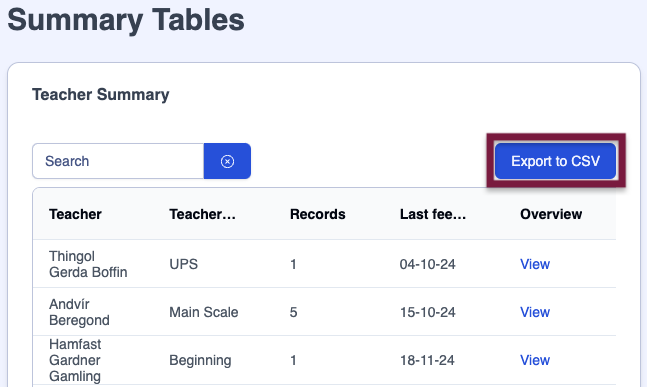
Who is receiving and giving feedback?
Many schools use the Feedback Coverage dashboard regularly to check their feedback schedule is being followed by leaders. To use this strategy in your school, do the following:
- Navigate to Dashboards > Feedback Coverage > Summary Tables
- Apply the required timeframe filter
- In the 'Feedback User Summary' table, use the sort feature on the 'Records' column to see how many feedback records have been created by leaders in the selected timeframe
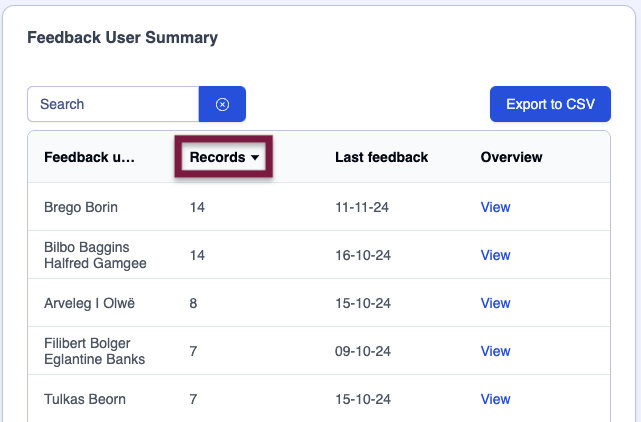
Tracking feedback coverage by Habit
Looking at schools’ data on the Feedback Coverage > Summary Tables > Coverage by Habit page, one observation we have made is that there can be a natural tendency for the behaviour or classroom culture Habit to be the area where most feedback is given, especially where leaders are conducting shorter lesson drop-ins. This raises useful questions about how much coverage we are giving to each area of pedagogy and about leaders’ varying levels of confidence in giving feedback across our Habits.


